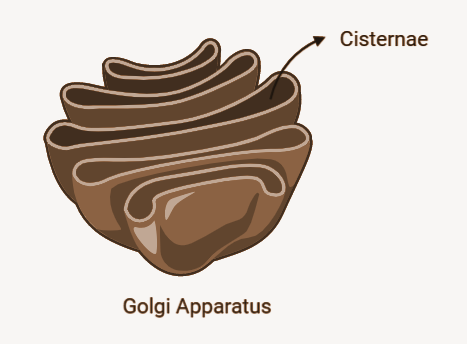
Cellulose and hemicellulose are the constituents of the cell wall which are synthesized by
A. Microbodies
B. Smooth endoplasmic reticulum
C. Lysosomes
D. Golgi apparatus
Answer
558.3k+ views
Hint: The cell wall is the outermost layer that is present in the plant cells only. It is a dead layer. It consists of three parts namely middle lamellae, primary cell wall, and secondary cell wall. Moreover, the primary cell wall is made up of cellulose and hemicellulose.
Complete answer: The golgi body or the golgi apparatus is a membrane-bound cell organelle. It is a series of flattened sac-like structures. Golgi apparatus performs a variety of functions. One such function is the synthesizing of the polysaccharides like cellulose and hemicellulose. The polysaccharides are synthesized by the vesicles of the golgi apparatus. These are then processed, packaged, and secreted to the surface of the cell plate. Due to this reason, the cell plate grows in thickness. This happens by the addition of these polysaccharides of cellulose and hemicellulose to the complex. Narrow openings that are known as the plasmodesmata are left in the cell plate and the cytoplasmic connections that are between the cells. These openings are retained in them throughout and help in the various exchanges along with the cells later on. When the development of the cell wall is occurring then the middle lamella is formed first. The middle lamella is made up of a gelatinous material of calcium and magnesium pectate. The middle lamella is a non-cellulosic layer. After this, the primary wall is secreted, and then the secondary wall. The primary wall is made up of intertwined cellulosic and hemicellulosic fibers. Finally, the secondary wall of cellulose, hemicellulose, suberin, lignin, pectin, etc. is secreted.

Thus, based on the above information we can conclude that cellulose and hemicellulose are the constituents of the cell wall which are synthesized by the golgi apparatus.
Hence, the correct answer is option (D).
Note: Immediately after the nuclear division occurs, the phragmoplasts appear in the cytoplasm which forms a cell plate. These phragmoplasts line themselves along the equator of the cell. After the process of mitosis ends, the granules that arise from the golgi apparatus arrange themselves on the center or the equator of the cell. All of these fuses form the cell plate.
Complete answer: The golgi body or the golgi apparatus is a membrane-bound cell organelle. It is a series of flattened sac-like structures. Golgi apparatus performs a variety of functions. One such function is the synthesizing of the polysaccharides like cellulose and hemicellulose. The polysaccharides are synthesized by the vesicles of the golgi apparatus. These are then processed, packaged, and secreted to the surface of the cell plate. Due to this reason, the cell plate grows in thickness. This happens by the addition of these polysaccharides of cellulose and hemicellulose to the complex. Narrow openings that are known as the plasmodesmata are left in the cell plate and the cytoplasmic connections that are between the cells. These openings are retained in them throughout and help in the various exchanges along with the cells later on. When the development of the cell wall is occurring then the middle lamella is formed first. The middle lamella is made up of a gelatinous material of calcium and magnesium pectate. The middle lamella is a non-cellulosic layer. After this, the primary wall is secreted, and then the secondary wall. The primary wall is made up of intertwined cellulosic and hemicellulosic fibers. Finally, the secondary wall of cellulose, hemicellulose, suberin, lignin, pectin, etc. is secreted.

Thus, based on the above information we can conclude that cellulose and hemicellulose are the constituents of the cell wall which are synthesized by the golgi apparatus.
Hence, the correct answer is option (D).
Note: Immediately after the nuclear division occurs, the phragmoplasts appear in the cytoplasm which forms a cell plate. These phragmoplasts line themselves along the equator of the cell. After the process of mitosis ends, the granules that arise from the golgi apparatus arrange themselves on the center or the equator of the cell. All of these fuses form the cell plate.
Recently Updated Pages
Master Class 11 Business Studies: Engaging Questions & Answers for Success

Master Class 11 English: Engaging Questions & Answers for Success

Master Class 11 Computer Science: Engaging Questions & Answers for Success

Master Class 11 Social Science: Engaging Questions & Answers for Success

Master Class 11 Maths: Engaging Questions & Answers for Success

Master Class 11 Biology: Engaging Questions & Answers for Success

Trending doubts
Differentiate between an exothermic and an endothermic class 11 chemistry CBSE

10 examples of friction in our daily life

One Metric ton is equal to kg A 10000 B 1000 C 100 class 11 physics CBSE

Difference Between Prokaryotic Cells and Eukaryotic Cells

State the laws of reflection of light

Explain zero factorial class 11 maths CBSE




